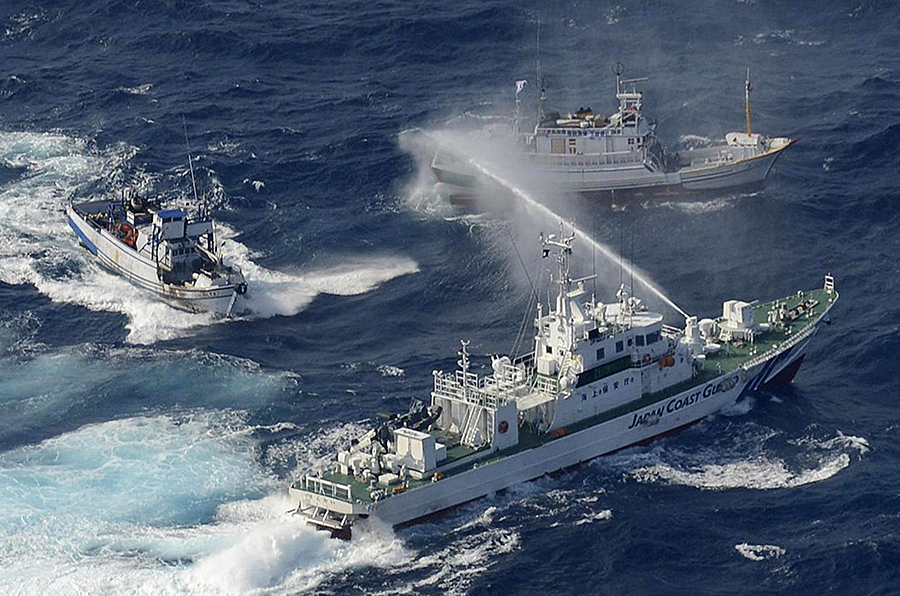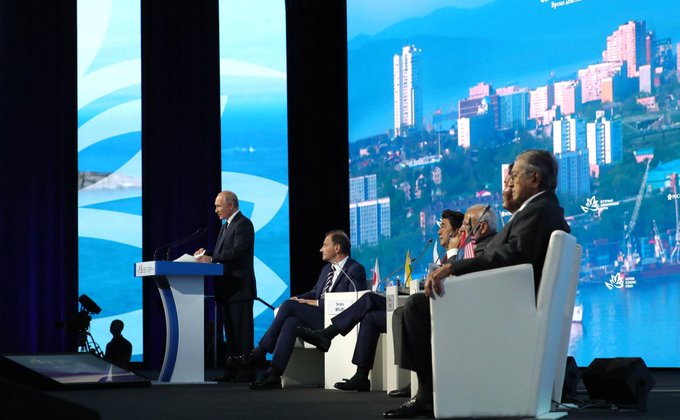October 2019
The Senkaku Paradox: Risking Great Power War Over
Small Stakes
By Michael E. O’Hanlon.
Brookings Institution, 2019, 258 pp.
How will a great-power nuclear war erupt? How can its outbreak be
prevented? These questions have bedeviled nuclear strategists and peace
advocates since the dawn of the Atomic Age and are gaining fresh urgency as
tensions among China, Russia, and the United States intensify.
Theorists generally assume that such a horrific cataclysm would occur
when the major powers have amassed large nuclear arsenals, have primed these
weapons for early use, and have reached a fever pitch of hostility. Under these
conditions, it is feared, any outbreak of armed hostilities could lead swiftly
to a clash of major conventional forces and, were one side or another to face
overwhelming defeat, the early use of nuclear weapons.
Historically, it was believed that such incidents would arise along
NATO-Soviet borders or in the North Atlantic, where the warships of the major
powers often crossed paths. To avert a nuclear catastrophe, global leaders
labored over the years to reduce tensions among the major powers through
U.S.-Soviet summits, UN sessions, intense diplomacy, and so forth and to reduce
the size and alert status of their nuclear arsenals. Unfortunately, less effort
has been directed at identifying potential flashpoints and reducing the risk of
uncontrolled escalatory spirals.
This lack of attention is especially critical in the current era of
great power competition, says Michael O’Hanlon of the Brookings Institution in
his new book The Senkaku Paradox: Risking Great Power War Over Small
Stakes. He claims that although the probability of a deliberate, full-scale
military assault by one of the major powers against another is extremely low,
significant risks remain for minor aggressions to escalate quickly. There is
considerable potential for a limited Russian intrusion into one of the Baltic
republics or a Chinese seizure of a Japanese-claimed island in the East China
Sea to spin out of control, possibly triggering the use of nuclear weapons.
Under existing U.S. military doctrine, he explains, any assault on a
NATO country or a U.S. treaty ally, however trivial, should automatically
prompt a full-scale military drive to reverse the intrusion and punish the
aggressor. Such an endeavor would require a full-scale mobilization of U.S. and
allied forces and still might not succeed, or if it did, it might so alarm
enemy officials that they might resort to launching nuclear weapons. Fearing
such an outcome, U.S. leaders might allow the original intrusion to stand,
thereby jeopardizing U.S. alliances and inviting further aggression, with every
likelihood that all-out war would eventually follow.
This, he explains, is what constitutes the “Senkaku paradox”: In the
event of a limited enemy aggression, say in the uninhabited Senkaku Islands of
the East China Sea, “a large-scale U.S. and allied response could seem
massively disproportionate.” On the other hand, “a nonresponse would be
unacceptable, and inconsistent with American treaty obligations.” What is
needed are credible responses that fall between the extremes of acquiescence to
aggression and military escalation.
O’Hanlon proposes an “asymmetric defense” consisting of economic
penalties and limited military actions. These could include sanctions aimed at
critical nodes of the aggressor’s economy, such as energy, banking, and
transport, along with air and missile strikes against key logistical targets,
such as pipelines, port facilities, and oil tankers. At the same time, the
United States and its allies would reinforce defense positions near the initial
conflict. The aim of all this would not be to reverse the original intrusion
but rather to demonstrate that any further aggression would be met with
intensified economic hardship and a brutal confrontation with U.S. and allied
armies.
In assessing U.S. strategic options, O’Hanlon focuses on three potential
flashpoints: the Baltic region, the East China Sea, and Taiwan. Of all
conceivable war-igniting scenarios involving the great powers, he suggests, the
most likely are a Russian attempt to seize a sliver of eastern Estonia or
Latvia, where Russian speakers are in the majority; a Chinese occupation of one
of the Senkaku Islands, claimed both by China, which calls them the Diaoyu’s,
and Japan; and a Chinese naval blockade of Taiwan to thwart any Taiwanese move
toward independence.
A Japan Coast Guard vessel sprays Taiwanese fishing
boats with water near the Senkaku islands in September 2012. The dispute over
the islands' sovereignty could create risks that a small conflict could
escalate quickly. (Photo: Yomiuri Shimbun/AFP/GettyImages)
In any of these scenarios, O’Hanlon claims, U.S. military policy would
presuppose a rapid and harsh response. Yet, any U.S. drive to dislodge Russian
or Chinese forces from those locations would require a major commitment of
force and, given recent improvements in those countries’ combat capabilities
(especially through the acquisition of high-tech weaponry), might not prove
easy to accomplish. A U.S. victory would be the most likely outcome, but could
prompt Russia or China to employ nuclear weapons. Far better, he argues, to
counter such assaults with asymmetric moves, such as attacks on vital energy
infrastructure located outside the Russian or Chinese heartland, along with the
reinforcement of positions in areas near the original intrusion.
O’Hanlon deserves credit for seeking credible alternatives to all-out
war as a response to low-stakes challenges of these sorts. His emphasis on
economic tools of coercion, as opposed to full-scale military mobilization,
merits close attention by U.S. strategists. He also performs an important
service by shining a spotlight on those potential flashpoints. Clearly, unless
greater effort is made to understand and defuse the sources of friction in all
three, other efforts to avert catastrophe could come to naught.
That said, many of his recommendations deserve careful scrutiny. Would
Russian or Chinese leaders consider attacks on their energy facilities and
logistical chokepoints as acceptable retribution? Perhaps such moves would
incite them to undertake even harsher countermeasures of their own. To punish
China for any future misbehavior in the East China Sea or in waters off Taiwan,
for example, he proposes blocking Chinese oil imports from the Persian Gulf, a
venture that he estimates will require four to six U.S. aircraft carriers and
supporting vessels and would likely initiate a major naval conflict in the
Indo-Pacific region. Although certainly superior to the immediate onset of
full-scale war, asymmetrical moves of this sort do not necessarily promise a pacific
outcome. Surely, O’Hanlon could have devoted more attention to preventative and
diplomatic endeavors, such as confidence-building measures and power-sharing
arrangements, such as for the Senkaku/Diaoyu Islands.
Indeed, the deeper lesson to be drawn from The Senkaku Paradox is
the difficulty in envisioning any outcomes from future U.S.-Russian or
U.S.-Chinese military encounters that do not risk a nuclear escalation. Modern
conventional weapons are capable of inflicting immense damage on vital military
infrastructure, including, conceivably, nuclear command-and-control facilities,
so it is easy to envision Russia or China responding with battlefield nuclear
weapons.
Asymmetric responses are a welcome contribution to the discussion of
alternative options, but a far more thorough reassessment of U.S. strategy is
required, aimed at reducing U.S. risk of military entanglement in far-off
hotspots and putting more space between conventional combat and the onset of
nuclear war.
Michael T. Klare is professor emeritus of peace and
world security studies at Hampshire College and senior visiting fellow at the
Arms Control Association.





/https://www.niagarafallsreview.ca/content/dam/thestar/news/canada/2021/09/25/huawei-executive-meng-wanzhou-receives-warm-welcome-upon-return-to-china/_1_meng_wanzhou_2.jpg)



No comments:
Post a Comment
Note: Only a member of this blog may post a comment.